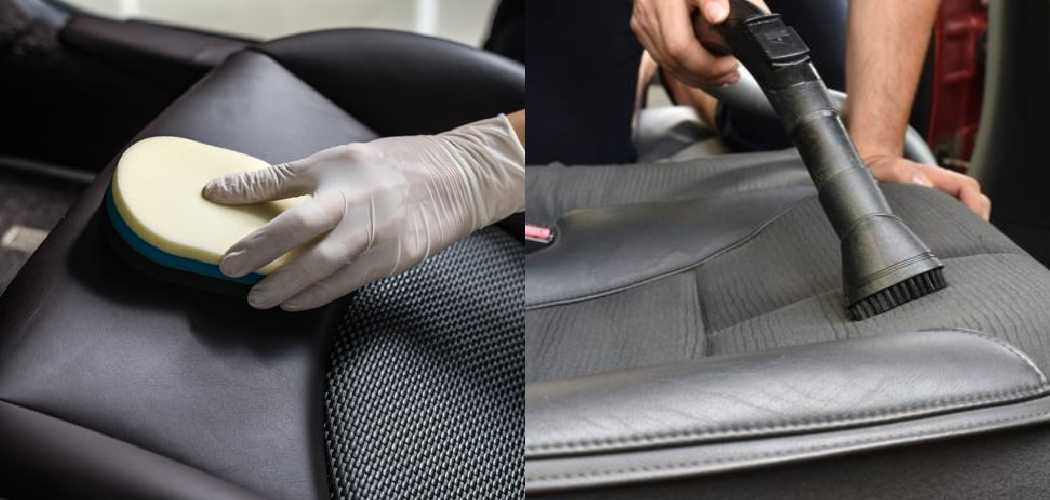If your car seat is anything like mine, it constantly seems to be covered in some sticky residue. Getting that residue off can be a hassle, whether from spilled soda or Cheetos crumbs. But with the right steps, it can be done relatively easily.
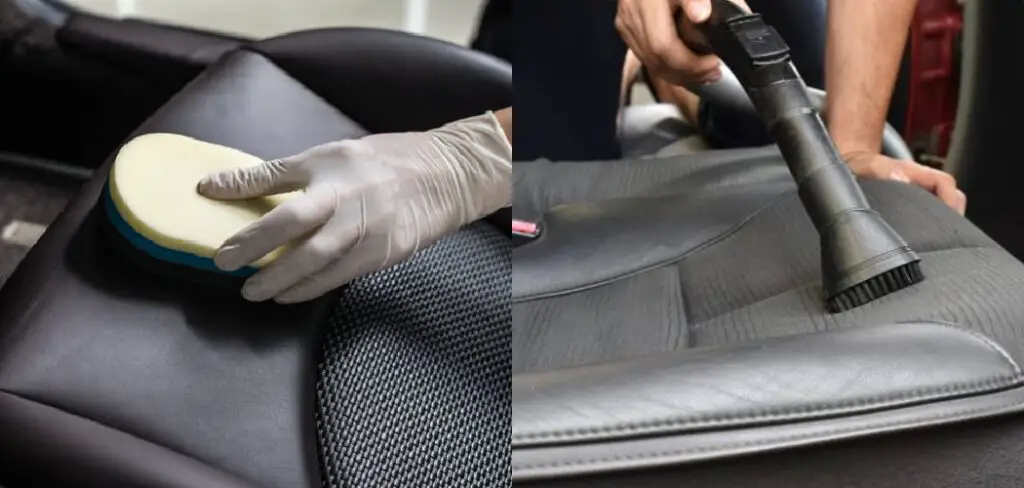
In this post, We’ll outline how to remove sticky residue from leather car seat. We’ll also give you some additional tips and advice to keep your car seat looking its best. So if you’re dealing with this issue, read on for tips that might help!
What is Sticky Residue?
Before we get into the removal process, it’s important to understand what exactly sticky residue is. Sticky residue can come from a variety of sources, such as food and drinks, spills, or even body oils and sweat. It can be tough to remove because it acts like glue on the surface of your leather car seat.
You may also notice that sticky residue can attract dirt and other particles, making it even more difficult to clean. If left untreated, it can eventually damage the leather and cause discoloration or stains.
So now that we know what we’re dealing with, let’s get into the steps to remove sticky residue from your leather car seat!
Why is It Important to Remove Sticky Residue?
Aside from the obvious reason for wanting a clean and spotless car seat, there are other reasons why it’s important to remove sticky residue. As mentioned before, if left untreated, it can cause damage to your leather seats. Additionally, sticky residue can also create an unpleasant smell in your car.
Furthermore, having sticky residue on your leather car seat can be unhygienic. Bacteria and germs can easily latch onto the residue, making your car a breeding ground for potential illnesses.
It’s also important to note that if you plan on selling or trading in your car, having a clean and well-maintained interior can increase its value. So, keeping your leather car seat free of sticky residue benefits not only you but also the overall resale value of your vehicle.
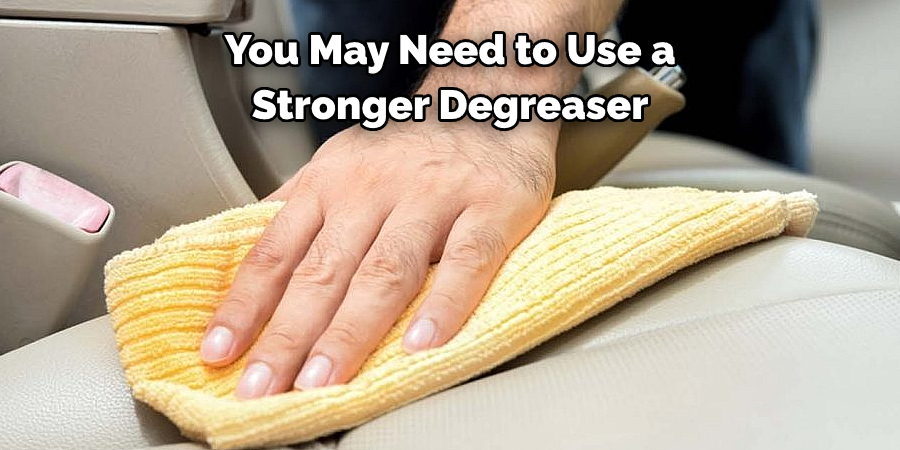
What You’ll Need
Before you begin, make sure you have the following items on hand:
A Clean Cloth or Sponge:
You’ll need a clean, soft cloth or sponge to use during the cleaning process. This will help you apply and remove the cleaning solution without damaging your car seat.
Warm Water:
For this method, you’ll need warm water to create a gentle cleaning solution. Make sure it’s not too hot, as it could damage the leather.
Mild Soap:
Choose a mild soap that is safe for use on leather. Avoid using harsh chemicals or detergents, as they can cause damage to your car seat.
Rubbing Alcohol:
Rubbing alcohol is a great option for removing sticky residue from leather. It’s gentle yet effective and won’t harm the material.
5 Common Reasons That Causes Sticky Residue on Leather Car Seats:
1. Spilled Liquids:
When liquids are spilled onto leather seats, they can leave behind a sticky residue. Common culprits include soda, coffee, and milk. If you notice a sticky spot on your leather car seat, it’s important to clean it up as soon as possible. Also, make sure that you blot the area dry with a clean cloth the next time you spill something on your leather car seat.
2. Food Crumbs:
Like liquids, food can also leave a sticky residue on leather car seats. Common culprits include candy, chocolate, and gum. Start by gently scraping away any food crumbs with a butter knife if you notice a sticky spot on your leather car seat. Next, make a paste out of equal parts baking soda and water. Rub the paste into the sticky residue, then wipe it away with a damp cloth. Finally, buff the area dry with a clean, soft cloth.
3. Oil Build-up:
Over time, your leather car seats can become sticky from oil build-up. This usually happens if you don’t regularly clean and condition your seats. You’ll need to use a degreaser to remove this sticky residue. You can either purchase a commercial degreaser or make your own by mixing equal parts water and vinegar. If your seats are very dirty, you may need to use a stronger degreaser.
To remove the sticky residue, vacuum your seats first to remove any loose dirt and debris. Next, apply the degreaser to a clean cloth and rub it into the affected areas. Be sure to work in small sections so the degreaser doesn’t dry out. Once you’ve treated the entire area, wipe it down with a clean, damp cloth to remove any leftover residue. Finally, apply a leather conditioner to help keep your seats looking like new.
4. Pen and Ink Stains:
If you have kids or pets, chances are you’ve dealt with pen or ink stains on your leather car seats. You’ll need to use a little elbow grease and a cleaning solution specifically designed for leather to remove these types of stains. Start by mixing a small amount of the leather cleaner with water in a bowl. Then, sponge the stain with the cleaning solution using a clean white cloth. Be sure to blot, rather than scrub, the stain. Once the stain has been removed, rinse the area with clean water and dry it off with a soft cloth.
5. Grease Stains:
Another common type of stain that you may come across is a grease stain. These can be tricky to remove, but there are a few things you can do. First, you will want to blot up as much grease as possible with a clean cloth.
Then, you can try using a leather cleaner or saddle soap on the stain. If that doesn’t work, you can try using a little bit of vinegar. Just be sure to test it on an inconspicuous spot first to ensure it won’t damage the leather. You can also try using a little bleach if your seat is white. Again, just be sure to use it sparingly and rinse it off well afterward.
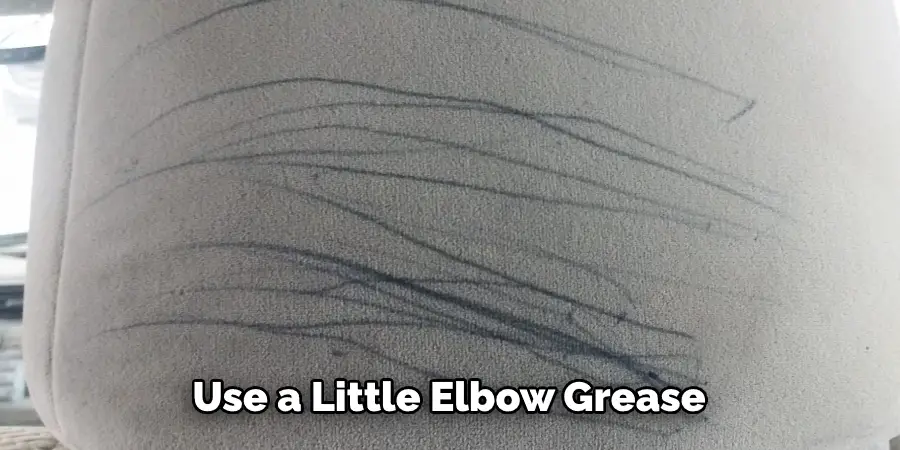
8 Effective Ways How to Remove Sticky Residue From Leather Car Seat:
1. Try Hot Water with Soap:
The first thing you should do is to try hot water with soap. This is usually the most gentle method and will work on most types of sticky residue. Simply soak a clean cloth in hot water and add a few drops of mild soap. Gently rub the cloth over the sticky residue until it loosens, then wipe it away with a damp cloth. If your leather is very delicate, you may want to try using baby shampoo instead of soap.
2. Use Vinegar or Alcohol:
If hot water and soap don’t work, you can try using vinegar or alcohol. Both of these will dissolve most types of sticky residue. Soak a clean cloth in either vinegar or alcohol and rub it over the sticky area. Wipe it away with a damp cloth afterward. Make sure you test this on a small area first to ensure it won’t damage your leather. If it does, try using a weaker solution or switch to another method.
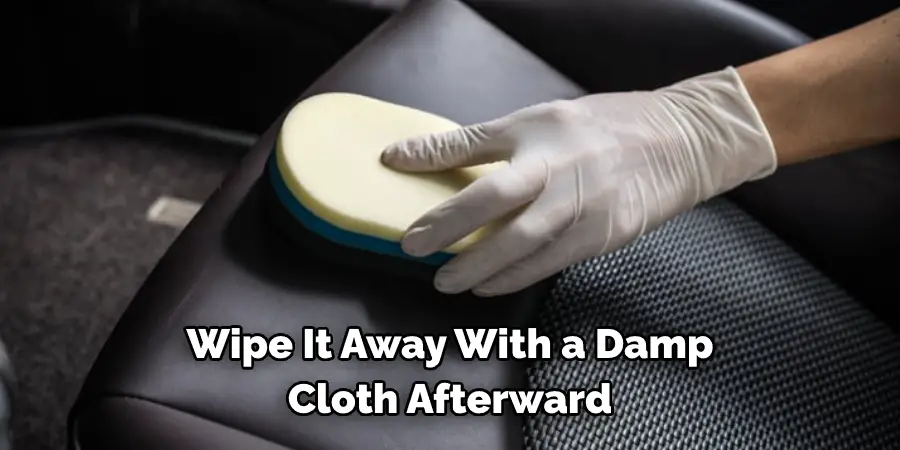
3. Use Olive Oil or Petrolatum:
If vinegar and alcohol don’t work, you can try using olive oil or petrolatum. Both will help to loosen the sticky residue so you can wipe it away. Simply apply a small amount to a clean cloth and rub it into the affected area. Then, use a second clean cloth to remove the oil or petrolatum and the residue. If your car seat is particularly dirty, you may need to repeat this process a few times.
4. Use a Commercial Cleaner:
If none of the above methods work, you can try using a commercial cleaner. Many market cleaners are specifically designed to remove sticky residue from leather car seats. Be sure to test the cleaner on a small, unnoticeable area of the seat first to ensure it does not damage or discolor the leather. Next, apply the cleaner according to the instructions on the label and then wipe away with a clean cloth. If this method does not work, you may need to consult a professional upholstery cleaner.
5. Try Any Organic Substance:
There are a few organic materials that can also do the trick when it comes to removing sticky residue from leather car seats. These include things like olive oil, peanut butter, and mayonnaise. Simply apply a small amount of any of these substances to the affected area and rub it in gently with a soft cloth. Allow it to sit for several minutes before wiping it away with a clean, damp cloth. The oils in these substances can help to break down the sticky residue, making it easier to remove.
6. Apply WD-40:
If you can’t seem to get the sticky residue off with any of the above methods, you may want to try using WD-40. First, spray a small WD-40 onto the affected area and rub it with a clean cloth. You may need to let the WD-40 sit on the area for a few minutes before wiping it away. Ensure the area is well-ventilated when using WD-40, as the fumes can be strong. Before trying it on a larger area, you should also test this method on a small, inconspicuous area of your leather car seat.
7. Try Nail Polish Remover:
Dab a cotton ball in nail polish remover, then press it against the sticky spot for a few seconds. Wipe away the residue with a clean cloth. If your car seat is made of suede, avoid using nail polish remover, as it may damage the material. Make sure the area is well ventilated before using nail polish remover. You may also want to test it on a small, hidden area first to ensure it won’t damage the leather.
8. Use Mild Detergent With Spray:
You can use any mild dish soap or laundry detergent to remove the sticky residue from your leather car seat. First, mix it with water in a bowl and apply it to the affected area using a clean cloth. Let it sit for a few minutes before wiping it off with a damp cloth. If the residue is still there, you can repeat this process until it’s gone. Be sure to rinse the area well and dry it off with a clean cloth afterward.
Following these methods on how to remove sticky residue from leather, you should be able to effectively remove any sticky residue from your leather car seats. Just remember to always test any cleaning solutions on a small, inconspicuous area first before applying it to the entire seat. This will help prevent any damage or discoloration to your leather. With proper care and maintenance, your leather car seats will stay clean and free of sticky residue. So next time you encounter any sticky mess, don’t panic – just refer back to these tips, and your car seats will look good and new in no time.
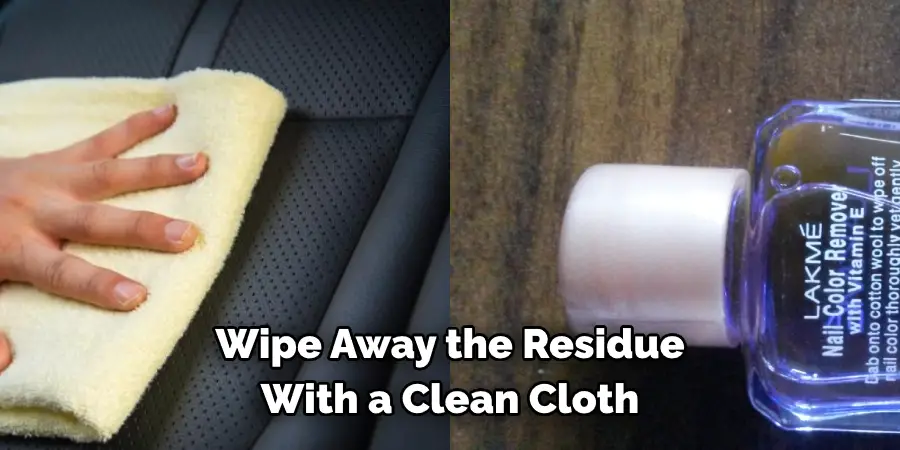
Tips to Prevent Sticky Residue in the Future:
1. Wipe Up Spills Immediately
The longer a spill sits on your leather, the greater the chance it will leave a residue. So wipe up any messes as soon as possible.
2. Choose Your Products Wisely.
When cleaning your leather seats, be sure to use products that are specifically designed for leather. Harsh chemicals can damage the leather, so it’s important to use gentle, leather-safe products.
3. Don’t Overdo It
Don’t scrub or use too much cleaner when cleaning your leather seats. A little bit of cleaner goes a long way, so you don’t need to douse the seats in cleaner. Just use a small amount and scrub gently.
4. Condition Regularly
To keep your leather seats looking their best, condition them regularly. This will help to prevent the leather from drying out and cracking. Choose a conditioner specifically designed for leather car seats and apply it every few months.
5. Use Protective Covers
If you have cloth or fabric seats, using seat covers can help protect them from spills and sticky residues. You can also use protective mats on the floor to catch any spills before they reach the seats.
6. Keep Sticky Items On Tray Tables
To prevent sticky messes, try to keep any food or drinks on tray tables when in the car. This will help contain any spills and prevent them from getting on your seats.
7. Regular Cleaning
Regularly cleaning your leather seats can help prevent any buildup of sticky residue. Make sure to vacuum and wipe down your seats on a regular basis to keep them clean and free of any residue. By following these tips, you can keep your leather car seats looking pristine and prevent any sticky messes in the future.
Frequently Asked Questions:
Q: Can I Use Alcohol on My Leather Car Seats to Remove Sticky Residue?
A: It’s not recommended to use alcohol on your leather seats as it can dry out and damage the material. Stick to using products specifically designed for leather. You can also try some of the organic substances mentioned above, like olive oil or mayonnaise. The oils in these substances can help to break down the sticky residue without damaging the leather.
Q: How Often Should I Clean My Leather Car Seats?
A: It’s recommended that you clean your leather seats every few months or as needed. Regular cleaning can help prevent the buildup of sticky residue and keep your seats looking their best. It’s also important to condition your seats every few months to keep the leather hydrated and prevent cracking. However, make sure not to overclean or use harsh chemicals, as this can damage the leather.
Q: Can I Use a Steam Cleaner on My Leather Car Seats?
A: It’s not recommended to use a steam cleaner on your leather seats as the high heat can damage the material. Stick to using gentle, leather-safe cleaning products and avoid using harsh chemicals or steam cleaners. If you’re unsure about a product or method, always test it on a small, hidden area first before applying it to the entire seat. This will help prevent any damage or discoloration to your leather.
Q: How Can I Tell if My Leather Car Seats Are Damaged?
A: Signs of damaged leather can include cracks, tears, faded color, or a rough texture. If you notice any of these signs, it’s important to address them as soon as possible to prevent further damage. Regular cleaning and conditioning can help keep your leather seats in good condition, but if you notice any significant damage, it’s best to consult a professional for repair options. Keeping your leather car seats clean and free of sticky residue not only helps to maintain their appearance but also increases their lifespan.
Conclusion
It is important to know how to remove sticky residue from leather car seats to protect the investment and keep the seats looking their best. If you have a leather car seat and are experiencing sticky residue, don’t worry. There is a way to remove it. All you need is some dish soap, water, and a cloth.
Be sure to test this method in an inconspicuous area before applying it to the entire seat. Following the steps we’ve outlined, you should be able to quickly and easily clean up any sticky mess. Have you ever had to deal with this kind of problem? What tips do you have for others who might find themselves in a similar situation? Share your thoughts in the comments below!
You Can Check It Out to Fix Leather Tear in Car

